Apple Mac Pro (Mid 2010) Review
by Anand Lal Shimpi on October 6, 2010 9:26 PM ESTPerformance
The new Mac Pro is fast, but then again so was the old one. Earlier this year I tried using the 15-inch Core i7 MacBook Pro as my notebook and desktop - my experiment lasted all of a day, I missed the performance. It’s not so much an issue of peak performance, but one of core count and noise. While I rarely run applications that demand four (or more) cores, running a lot of applications that each eat 5 - 25% of a single core at the same time adds up. I also found that confined to a relatively thin notebook fans spun faster under typical CPU loads for me, as a result the overall system produced more noise than a larger tower.
I’ve got three Mac Pros represented in the charts below. The original late 2006 Mac Pro but upgraded to two 3.0GHz quad-core CPUs (effectively making it an early 2008 Mac Pro), the early 2009 Nehalem based Mac Pro once again upgraded to a pair of 2.93GHz quad-core CPUs and of course the new 2010 Mac Pro in its default eight-core configuration (2 x 2.4GHz quad-core CPUs).
Westmere only brought mild IPC improvements, so it shouldn’t really offer any tangible performance advantage over last year’s model. The only benefits will really be power, but let’s go down the list to put things in perspective.
Cinebench R10 & 11.5
Most applications won’t stress the 16 threads you get in the eight-core Mac Pro with the exception of offline 3D rendering of course. We’ll start out with Cinebench R10:
The single threaded shows how far we’ve come in single threaded performance just comparing Conroe to Nehalem. At roughly the same clock speed the 2009 Mac Pro manages a 25% performance improvement over the 2008 Mac Pro. Part of the advantage is obviously due to single threaded turbo mode, but it’s an advantage nonetheless. If you have a higher clocked Nehalem Mac Pro you’ll need to upgrade to something at least as fast as what you have now, the 2.4GHz default clock of the eight core system is simply too low to offer any advantage over the higher clocked alternatives in this chart.
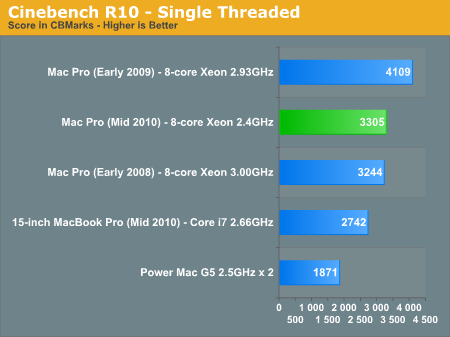
I also threw in the dual processor Power Mac G5 2.5GHz to put things in perspective. While a highly configured Mac Pro from 2008 may not be in need of an upgrade, if you’re still doing work on a Power Mac G5 an upgrade would be very appreciated. Westmere is 76% faster than the 2.5GHz G5 in this single threaded test.
Multithreaded performance scales very well on Nehalem and Westmere as you can see below:

The key takeaway here is that if you had a high clocked, eight-core Mac Pro from 2008 you can’t get away with the new 2.4GHz eight-core. The extra threads help but you need clock speed as well to manage a significant performance advantage over what you’re upgrading from.
The G5 comparison is even more ridiculous when we look at multithreaded performance. A single Westmere core running at 2.4GHz is nearly as fast as two 2.5GHz PowerPC 970FXes in Cinebench R10’s multithreaded test.
We see a similar story if we look at Cinebench 11.5 results:
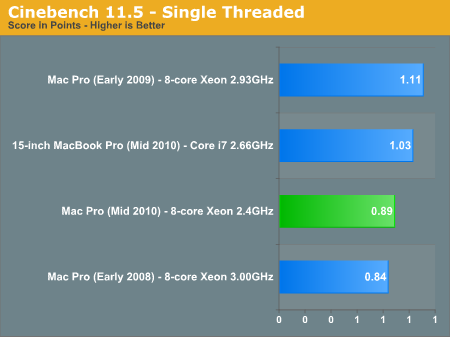
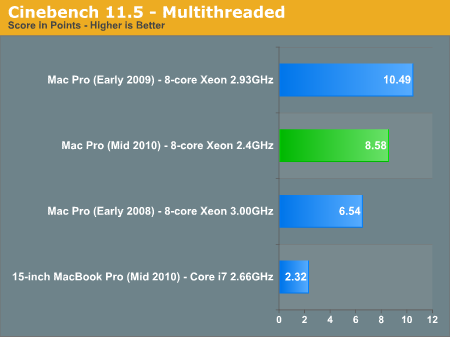
The newer benchmark is less bound by the performance of a single thread and thus we see it favoring the 2-threads-per-core you get from Nehalem/Westmere. In this case the 2.4GHz $3499 eight-core Mac Pro is faster than the 3.0GHz eight-core Mac Pro from 2008.
Remember that until Sandy Bridge, the L3 cache is the means of core-to-core communication in Intel’s Core series of processors. There was no single large shared cache in the 2006 - 2008 Mac Pro (each set of 2 cores shared an L2 cache) which is the reason for the relatively poor scaling there. Westmere gives you a larger L3 to play with and thus we see slightly better scaling from one to 16 threads vs. Nehalem. The size of the L3 cache in Westmere means that you can store more data shared by all of the cores in these heavily threaded applications.
Adobe Photoshop CS4 Performance
Photoshop is one of those benchmarks that really stresses everything. You get decent memory and I/O dependency and good use of multiple cores (but diminishing returns beyond 6 - 8 threads).
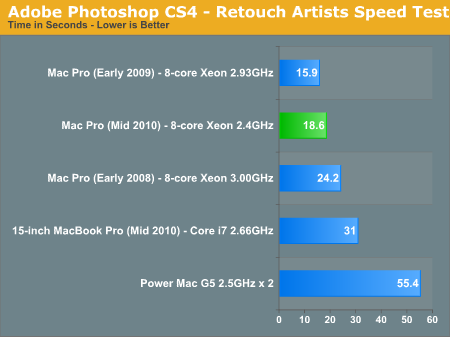
We’ve already shown the new Mac mini is nearly as fast as the Power Mac G5 in Photoshop, but the new Mac Pro cuts our test time in less than half compared to the old G5. The Westmere advantage is not tremendous here, some higher clocked Nehalems do better in this test.
Even the 2008 Mac Pro does well here, at least compared to the G5.
Aperture 2 RAW Import Performance
For my Aperture test I simply timed how long it took to import 203 12MP RAW images into the library.
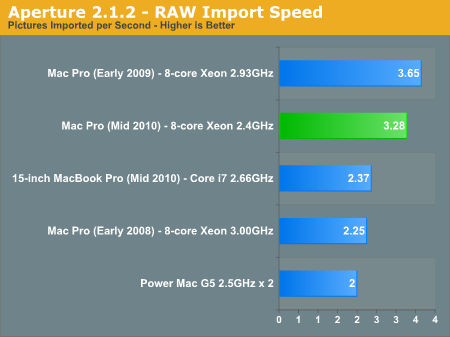
The 2009/2010 Mac Pros are very fast even in general use tasks like importing images into Aperture.
H.264 High Profile Transcoding
I have a feeling the transcoding game is going to get a lot more complicated after Sandy Bridge hits next year, but until then we’ve got our typical H.264 encoding tests. Here I’m taking a 90Mbps H.264 source file and transcoding it using Handbrake and the default High Profile settings.
The transcoding process peaks at about 11 threads, so there is an advantage to the Hyper Threading enabled systems but it’s not much. The sub-max thread count allows even the older 2008 Mac Pro to outpace the newcomer simply because of the system’s higher clocked CPUs in this case:
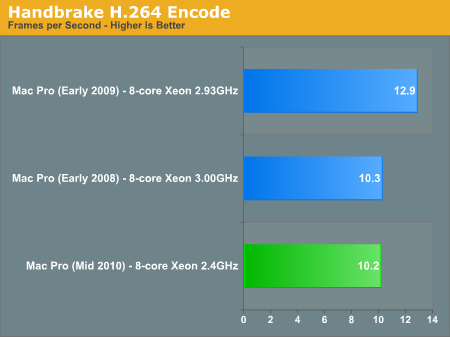
Clock for clock there is at least a 25% increase in performance over the old Mac Pro given the same number of cores. I wouldn’t expect a huge improvement vs. Nehalem at the same clock speed however.










84 Comments
View All Comments
jasperjones - Thursday, October 7, 2010 - link
OS X hasn't supported NUMA for the longest time. imo it's of some importance on a dual-socket system with 8 or 12 cores. So, question: has Apple finally got around to make it work with the Mac Pro '10? If not, I assume that similarly-configured Dell and HP systems which run Linux or Windows will perform better in some scenarios.metaungulate - Thursday, October 7, 2010 - link
The KVR1333D3K3/3GR is Unbuffered. This won't work.Ben90 - Thursday, October 7, 2010 - link
Xeons support ECC not require it.Stuka87 - Thursday, October 7, 2010 - link
Buffered and ECC are different, and should not be confused with each other. Older Xeon's did use FBDIMM's, but current Xeons use standard DDR in either Non-ECC, ECC, or Buffered ECC unless the chipset used specifically calls for one or the other.metaungulate - Thursday, October 7, 2010 - link
Thank you for the clarification. However, these are the current prices on newegg.com:Intel Xeon E5620 Westmere 2.4GHz 12MB L3 Cache LGA 1366 80W Quad-Core Server Processor BX80614E5620: $384.99 x 2
Kingston ValueRAM 3GB (3 x 1GB) 240-Pin DDR3 SDRAM DDR3 1333 (PC3 10666) Triple Channel Kit Desktop Memory Model KVR1333D3K3/3GR: $60.99 x 2
SAPPHIRE 100283-3L Radeon HD 5770 1GB 128-bit GDDR5 PCI Express 2.0 x16 HDCP Ready CrossFireX Support Video Card: $139.99
Western Digital Caviar Black WD1001FALS 1TB 7200 RPM 32MB Cache SATA 3.0Gb/s 3.5" Internal Hard Drive -Bare Drive: $79.99
LG Black 24X DVD+R 8X DVD+RW 16X DVD+R DL 24X DVD-R 6X DVD-RW 12X DVD-RAM 16X DVD-ROM 48X CD-R 32X CD-RW 48X CD-ROM SATA DVD Burner - Bulk LightScribe Support - OEM: $20.99
Corsair Obsidian Series 700D CC700D Black Aluminum / Steel ATX Full Tower Computer Case: $249.99
Antec TruePower New TP-750 750W Continuous Power ATX12V V2.3 / EPS12V V2.91 SLI Certified CrossFire Ready 80 PLUS BRONZE Certified Active PFC: $109.99
ASUS Z8NA-D6C Dual LGA 1366 Intel 5500 ATX Dual Intel Xeon 5500 and 5600 Series Server/Workstation Motherboard: $259.99
On what planet is this: $1612.91?
The actual cost is: $1,752.90.
Anand Lal Shimpi - Thursday, October 7, 2010 - link
That's the issue with non-realtime pricing, it changes. I've updated to the latest numbers :)kevin2i - Sunday, October 31, 2010 - link
The article is still wrong -- pricing does not include an OS.1752 Parts
199 Windows 7 Professional
Didn't see wifi/bluetooth, firewire, mouse, keyboard either.
iLife suite? - The user may or may not find it useful. Although I have Final Cut, I typically use iMovie for simple tasks.
Home box: No real warranty, no resale value -
The apple tax is looking more like a refund compared to a home built system.
zorxd - Thursday, October 7, 2010 - link
The Apple tax is clearly there. Only, there is also a Dell tax this time.Also, the Apple tax would look even worse if you compared the single socket system, since you could get a Core i7 (or maybe even i5) instead of the Xeon for the same (or better) performance with a much cheaper motherboard and CPU.
metaungulate - Thursday, October 7, 2010 - link
Yeah, don't get me wrong, I still think that the build is the way to go at $1752.90. Just pointing out that if Anandtech wants to be such a trusted technical resource it would help if the writers knew how to use a calculator. :)Nadav2010MP - Friday, October 8, 2010 - link
But, for those like me who have a 2009 mac pro, all I had to do was spend 300 dollars for the two main parts to make my 09 a 2010.. The backplane board 661-5706 was only 250.00 from an on-line site.. and the processor board only cost me 46.00 - so, for 300.00, using the w3580, my 8GB 1066 mhz memory and 5770 - I was able to remove the original 09 parts and replace them with 2010 parts.. The heatsink from the 09 is the EXACTLY same as the 2010... rather the other way.. the 2010 uses the same 09 parts, some are marked with different part numbers to distinguish them, but for the most part.. all fans, case components work on the 2010 backplane board, as this board is the same exact board as in the 09 except Apple flashed it with the firmware to support westmere and 1333 mhz memory.Dual is a totally different story... it wouldn't be cost effective to move from a single to a dual because you lack the heatsinks(those two alone would be near 400 dollars), while the dual processor board would only be 76 dollars(macpartsonline.com), you still need the dual processors and THOSE ALONE would cost more than the machine or come close to the cost of a new 2010 already.
The upgrade from 09 single to 2010 single can be done for 300.00 and thats it.. you are done. But the dual would cost far more.